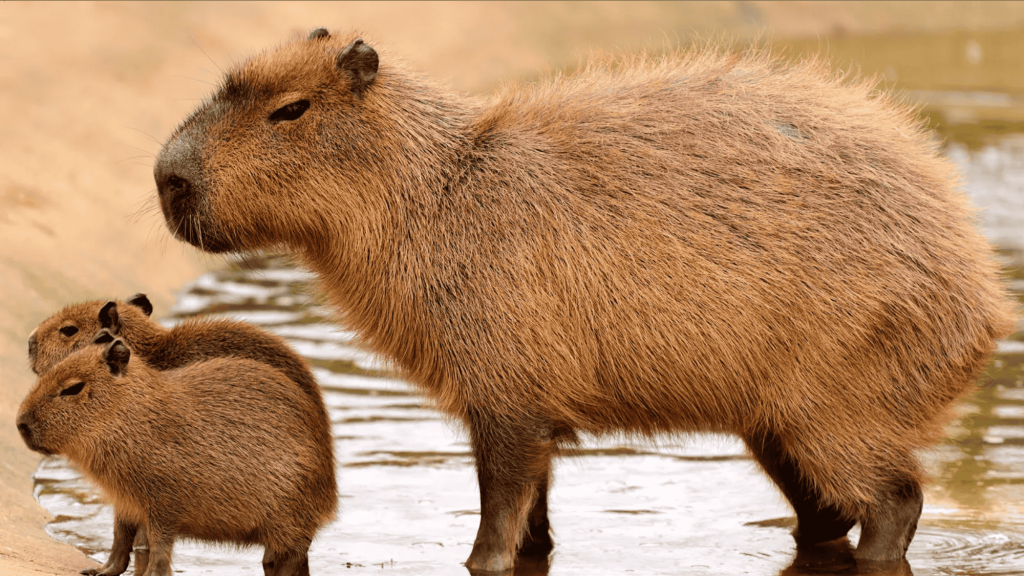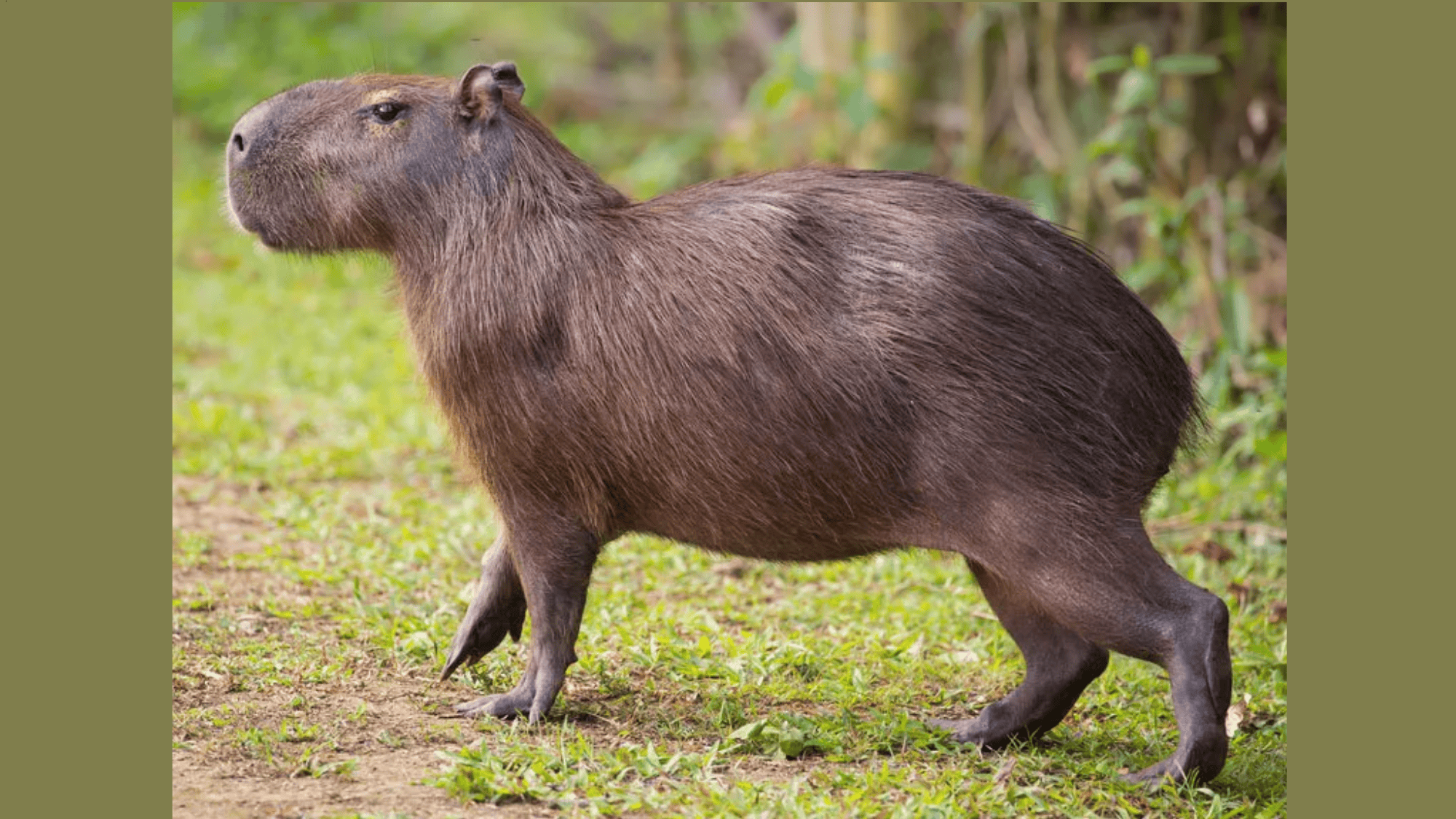Capybaras have gained significant attention as both exotic pets and social media stars in recent years.
These large South American rodents often appear in viral videos lounging with various animals, from birds to crocodiles, giving the impression of a naturally calm disposition.
Yet, for those considering adding capybaras to their homes or simply curious about wildlife safety, questions frequently arise about how these animals behave around humans.
Are these giant rodents actually safe to be around? What behaviors might indicate potential problems?
Let’s look closer at how capybaras act in daily life and what their behavior can tell us about being around them.
A Detailed Overview of Capybaras
Capybaras are unique semi-aquatic rodents, perfectly adapted to their watery habitats and known for their strong social bonds.
Physical Characteristics
Capybaras are the largest living rodents in the world, with distinctive features that make them immediately recognizable:
- Weight ranges from 77 to 146 pounds (35 to 66 kg)
- Body length typically measures between 3.5 to 4.4 feet (1.1 to 1.3 meters)
- Short, coarse fur ranging from reddish-brown to gray
- Semi-webbed feet for swimming
- Blunt snouts with eyes and ears positioned high on their heads
- Strong, large teeth that continue growing throughout their lives
Native to South America, particularly Brazil, Venezuela, Colombia, and other countries with wetland areas, these semi-aquatic mammals have adapted perfectly to life near water bodies.
Their natural habitat includes marshes, swamps, rivers, and lakes where they can quickly retreat when feeling threatened.
Social and Behavioral Structure
Capybaras are social animals that live in groups of 10 to 40 in the wild, and this group lifestyle significantly influences their behavior.
They usually form tight family groups led by a dominant male.
Communication includes purrs, clicks, whistles, and barks, while social grooming helps maintain strong bonds.
When resting, they often huddle for warmth and safety, and they rarely spend time alone, as isolation can cause stress.
Naturally cautious, capybaras prefer to flee rather than fight when threatened.
Do They Attack Humans?
The short answer is yes, but it also depends on the situation.
Capybaras rarely attack humans without significant provocation. These animals typically prefer to avoid confrontation rather than initiate it.
Unlike some wild animals that may view humans as potential prey or competitors, capybaras generally show indifference or mild curiosity toward people when properly socialized.
Their first instinct when uncomfortable is to move away rather than to attack.
However, like any wild animal, even one kept as a pet, capybaras can react defensively in certain situations.
Do They Bite?
Capybaras possess large, sharp teeth designed for grinding plant material.
While not naturally inclined to bite humans, they can and will bite if they feel threatened or cornered with no escape route. When a capybara does bite:
- Their teeth can cause significant puncture wounds
- They have strong jaw muscles capable of exerting considerable pressure
- Bites often occur as a last resort when other warning signals have been ignored
- Young children are at higher risk due to unpredictable movements and a lack of understanding of animal cues
Most reported bites occur in situations where the capybara felt trapped or was handled roughly. Responsible interaction significantly reduces this risk.
Reasons They May Show Defensive Behavior
Several specific circumstances might prompt defensive responses from capybaras:
- Protecting Young: Adult capybaras, particularly females, become protective when caring for their offspring. Approaching baby capybaras can trigger defensive responses from parents.
- Feeling Threatened or Cornered: When capybaras cannot access an escape route (particularly water), they may display defensive behaviors if they feel threatened.
- Territorial Behavior: Capybaras are very territorial, especially regarding their living space and social groups. They may react defensively when they perceive humans as intruders in their established territory.
- Resource Guarding: They may protect food, favorite resting spots, or water access, though this is less common than in some other animals.
- Mating Season Changes: Males might show territorial behavior during breeding seasons, occasionally directing this toward humans who enter their space.
How to Handle a Capybara When They Show Signs of Stress?
If a capybara displays signs of discomfort or stress, the proper response can prevent escalation:
- Read Body Language Carefully: Look for raised hair, teeth chattering, stiff posture, or freezing behavior. These indicate the capybara feels uncomfortable.
- Move Slowly and Speak Softly: Quick movements or loud noises can intensify their stress response. Calm, gentle movements help maintain a peaceful interaction.
- Create Space: Simply backing away often allows the capybara to feel secure again. They rarely pursue humans once the perceived threat has moved a comfortable distance away.
- Avoid Direct Eye Contact: Looking directly at a nervous capybara can be interpreted as threatening. Instead, look slightly away while still monitoring their position.
- Use Food Distractions with Caution: While a favorite treat might redirect attention, feeding a stressed animal can also reinforce unwanted behaviors.
The Bottom Line
Capybaras, despite their impressive size and powerful teeth, pose minimal danger to humans under normal circumstances.
Their natural tendency toward flight rather than fight makes them generally peaceful creatures to observe and, where legally permitted, to keep as exotic pets.
Understanding their communication signals and responding appropriately to signs of stress creates the basis for positive human-capybara interactions.
With appropriate knowledge, reasonable expectations, and responsible management, capybaras can coexist peacefully with humans.





















